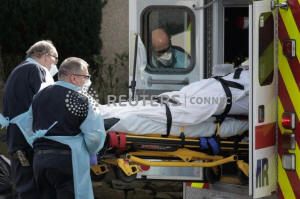U.S. states scramble to slow virus spread, prevent hospital collapse
 Send a link to a friend
Send a link to a friend
 [March 13, 2020]
By Andrew Hay [March 13, 2020]
By Andrew Hay
(Reuters) - From cancelling Broadway shows
to closing schools, U.S. states are scrambling to slow the spread of
coronavirus and stop hospitals from being overwhelmed with a surge in
critically ill patients, as has been the case in Italy.
After weeks of federal officials telling Americans they faced low risk
from the virus, and with no widescale testing to track its spread,
hospitals in hard-hit cities like Seattle are now fighting to save lives
as COVID-19 tears through communities.
One Seattle, Washington hospital has triage tents outside, two for
possible COVID-19 cases, one for anything else. Nearby walk in clinics
ask patients who think they have the virus wait in cars to avoid the
potential of infecting others.
In Hawaii, another state that rapidly responded to the outbreak, urgent
care clinics offer drive-through testing.
U.S. hospitals are being helped by a rapid shift in state strategy from
containing the virus to mass mitigation measures to slow its spread.
These measures, ranging from bans on large gatherings in Washington
state and California to a containment zone in New York and school
closures in Maryland and Ohio, are meant to reduce the rate at which
people are infected and seriously-ill patients show up at emergency
departments.

The goal is to prevent the kind of surges that overwhelmed Italy - a
country with more doctors and hospital beds per capita than the United
States - causing fatality levels to leap as doctors ran out of equipment
to help people breathe.
U.S. states that wait too long to stem the spread of contagion may find
hospitals trapped in this doom spiral, experts warn.
Italy's confirmed cases of coronavirus have leapt from around 300 cases
at the end of February to over 12,000 Thursday, providing a preview of
what awaits America if measures aren't taken quickly to mitigate the
spread. The Italian College of Anesthesia, Analgesia, Resuscitation and
Intensive Care published guidelines instructing healthcare workers to
provide scarce hospital resources to those who stand "the highest
likelihood of survival."
LIKE MAJOR QUAKE
The biggest U.S. battle is in greater-Seattle, an area with over a
quarter of the country's more than 1,300 U.S. COVID-19 cases and the
bulk of the 39 deaths.
On the front lines, with limited testing, it can be an individual nurse
practitioner or doctor who decides if a person is treated as a COVID-19
patient, or not.
"Our staff can use their clinical judgment and consider that patient to
be likely positive if they choose," said Megan Farnsworth, an emergency
room doctor in Everett, Washington dealing with high patient volumes at
clinics she oversees.
Washington officials have prepared residents for a large-scale outbreak
of the virus ten times as deadly as the flu that would double in size
every five to eight days.
"It's something similar to the infectious-disease equivalent of a major
earthquake that is going to shake us for weeks and weeks," said Jeff
Duchin, health officer for Seattle's King County.
[to top of second column]
|

Medics transport a patient into an ambulance at the Life Care Center
of Kirkland, the Seattle-area nursing home at the epicenter of one
of the biggest coronavirus outbreaks in the United States, in
Kirkland, Washington, U.S. March 12, 2020. REUTERS/David Ryder

Few places in the United States are better prepared for this fight
than the cities of Seattle and Everett, where their hospitals have
been readying for a largescale community spread since late January
when the area reported the country's first COVID-19 case. Despite
limitations, greater-Seattle may have the best testing in the
country.
"Being able to know who has the virus and who does not is able to
free up beds, isolation units," said Alex Greninger, assistant
director of University of Washington Medicine Clinical Virology
Laboratories, which is testing over 1,000 people a day.
Doctor Janet Englund can get a test result back in between 12 and 36
hours.
"I think other states and sites are looking at what we are finding
and what we are doing," said Englund, an infectious disease
specialist at Seattle Children's, which has yet to see a high number
of COVID-19 patients.
PROTECTIVE GEAR
Emergency medicine professionals in other U.S. states tell a
different story, with doctors only able to test acutely ill patients
and colleagues not wearing protective gear.
"None of the nurses, no one is wearing them. I put on my own N95
mask and everyone laughed at me," said an emergency room doctor in a
southern U.S. state, who asked not to be named. "We donít know who
has it and, especially healthcare workers need to be tested, because
we can give it to everybody else."
Jeremy Konyndyk, a senior policy fellow at the Center for Global
Development in Washington, has heard similar accounts.
"Many hospitals in this country, as of last week, really had not
woken up to what this was about to throw at them and had not begun
putting measures in place to be ready for that," said Konyndyk,
describing the federal government's "wait and see" public health
guidance as "unspeakably irresponsible."

Personal protective equipment such as CAPR respirator masks used by
emergency room staff are in high demand, Farnsworth said. Her
hospital network is shifting supplies to areas in greatest need.
Ultimately, the ability of hospitals to save lives will rest on the
speed at which states apply mitigation. If taken early enough,
aggressive measures like lockdowns can all but flatten the spread of
the disease.
"I think we do need to take more of a no regrets approach," said
Konyndyk, adding that it might be impossible to enforce Wuhan-style,
mandatory lockdowns in the United States.
(Reporting by Andrew Hay; editing by Bill Tarrant and Diane Craft)
[© 2020 Thomson Reuters. All rights
reserved.] Copyright 2020 Reuters. All rights reserved. This material may not be published,
broadcast, rewritten or redistributed.
Thompson Reuters is solely responsible for this content. |